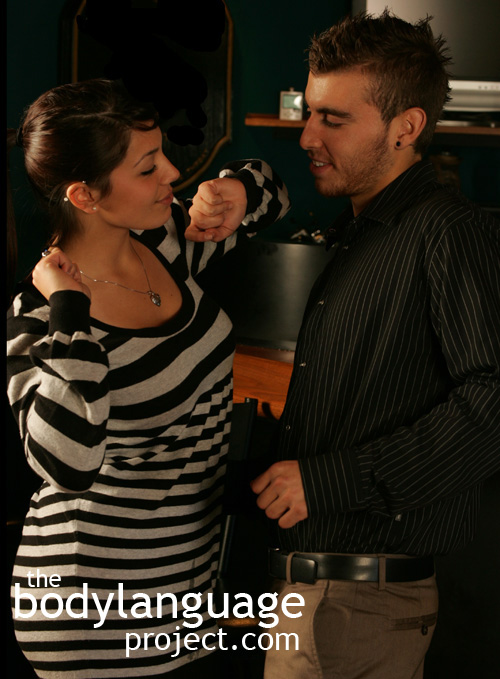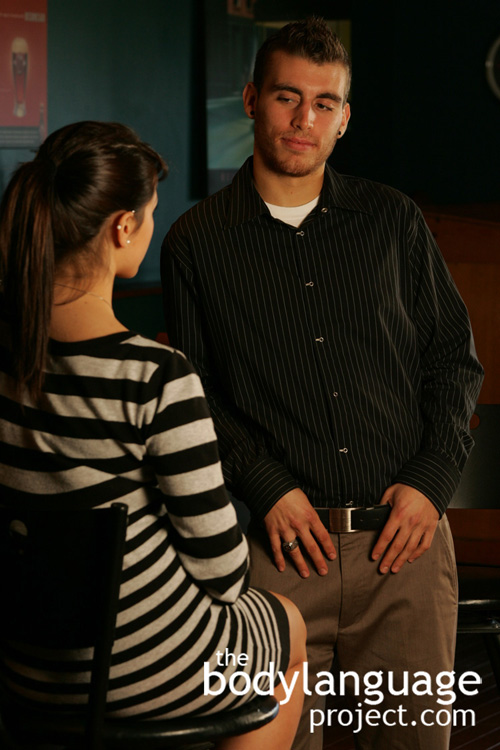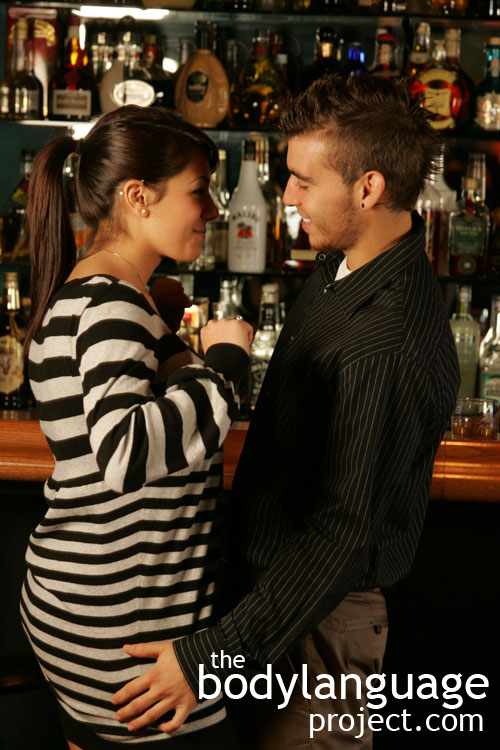Body Language Of Echoing
Synonym(s): Related to Mirroring
Description: Echoing is like mirroring where similar body postures are replicated, but not right away. Instead they are copied some time later. Echoing can be so prominent that it appears fluent. Bodies seem to jive as if in an elaborate dance.
In One Sentence: Echoing is a nonverbal tactic or behaviour that happens naturally to show agreement in which a person copies or nearly copies the gestures and postures of another person, not immediately, but with a few seconds or minutes of separation.
How To Use it: Echoing is a great way to create nonverbal liking through subconscious means. By adopting the postures and gestures of others a few seconds after they have initiated them, it will create similar feelings. If done correctly, echoing produces strong liking and builds relationships quickly.
Echoing works equally well in business as it does in dating and friendships. To use echoing make sure that postures are not mimicked exactly in a copy-cat fashion, but instead happen similarly. Should someone catch on to your game, they may become suspicious. Therefore echoing should be done with some degree of caution.
The best kind of echoing happens when it is done naturally and this is the case when two people really seem to jive and get along with one another. Echoing is a nonverbal form of agreement.
Context: General.
Verbal Translation: “We’re almost on the same page, as we are copying each other but not immediately like mirroring. Since our bodies are flowing in a similar pattern our minds are flowing in a similar pattern – therefore we agree with each other and have strong rapport.”
Variant: See Mirroring.
Cue In Action: Some ways bodies echo:
[A] Shifting weight from one foot to the other foot or keeping the weight on the same foot as the person you are talking with.
[B] Leaning the same way on a bar top or up against a wall or other structure.
[C] Crossing the legs in the same direction or opposite direction when facing each other.
[D] Both keeping the legs uncrossed.
[E] Gesturing with the hands similarly.
[F] Drinking in unison or holding drinks with the same hand.
[G] Placing both hands, or just one hand, on the hips.
[H] Leaning in, or leaning out.
Meaning and/or Motivation: Echoing indicates that rapport is being built between two people and that agreement is taking place. In echoing, postures and gestures are not concurrent with what is going on with others, but instead happen after some time has elapsed.
Echoing the gestures and postures of another person, often happens within thirty seconds to a minute after another person. However, it can sometimes even happen with several minutes of separation. When gestures and postures happen simultaneously, on the other hand, we call this mirroring.
When echoing is present rapport is felt between two people. We say that these people are on the same “wavelength.”
Cue Cluster: N/A
Body Language Category: Attentive, Buy signals, Courtship displays, Comfort body language, Honest body language, Indicator of interest (IoI), Indicators of sexual interest (IOsI), Liking, Nonthreatening body language, Rapport or rapport building, Relaxed body language.
Resources:
Bavelas, J. B., Black, A., Chovil, N., Lemery, C. R., & Mullett, J. (1988). Form and function in motor mimicry: Topographic evidence that the primary function is communicative. Human Communication Research, 14, 275- 299.
Bavelas, J. B., Black, A., Lemery, C. R., & Mullett, J. (1986). “I show how you feel”: Motor mimicry as a communicative act. Journal of Personality and Social Psychology, 50, 322-329.
Chartrand, T. L.,& Bargh, J. A. (1999). The chameleon effect: The perception behavior link and social interaction. Journal of Personality and Social Psychology, 76, 893-910.
Cooper, Ella A.; John Garlick; Eric Featherstone; Valerie Voon; Tania Singer; Hugo D. Critchley and Neil A. Harrison. You Turn Me Cold: Evidence for Temperature Contagion. PLoS ONE 9(12): e116126. doi:10.1371/journal.pone.0116126.
http://bodylanguageproject.com/articles/mirror-cold-nonverbals-influence-real-body-temperate-others/
Cooper, L. 1976. Mirroring: One vehicle to organizational clarity. International Journal Of Social Psychiatry 22 (4): 288-295.
di Pellegrino, G.; L. Fadiga; L. Fogassi; V. Gallese, and G. Rizzolatti. Understanding Motor Events: A Neurophysiological Study. Experimental Brain Research. 1992. 91:176-180
http://bodylanguageproject.com/articles/mirror-neurons-make-emotions-body-language-contagious/
Dezecache, Guillaume; Laurence Conty; Michele Chadwick; Leonor Philip; Robert Soussignan; Dan Sperber and Julie Grezes. Evidence for Unintentional Emotional Contagion Beyond Dyads. PLoS ONE. 2013. 8(6): e67371. doi:10.1371/journal.pone.0067371
http://bodylanguageproject.com/articles/emotion-collective-crowd-emotions-really-contagious
Guéguen, Nicolas; Martin, Angelique and Sebastien Meineri. Mimicry and Helping Behavior: An Evaluation of Mimicry on Explicit Helping Request. The Journal of Social Psychology. 2011. 51(1), 1–4
http://bodylanguageproject.com/articles/mimicking-way-compliance-mirroring-body-language-another-leads-helping-behaviour/
Grammer, Karl ; Kruck, Kirsten ; Magnusson, Magnus. The Courtship Dance: Patterns of Nonverbal Synchronization in Opposite-Sex Encounters. Journal of Nonverbal Behavior, 1998, Vol.22(1), pp.3-29.
Hofree G, Ruvolo P, Bartlett MS, Winkielman P. Bridging the Mechanical and the Human Mind: Spontaneous Mimicry of a Physically Present Android. PLoS ONE. 2014. 9(7): e99934. doi:10.1371/journal.pone.0099934.
http://bodylanguageproject.com/articles/humans-cant-help-mirror-robots-nonverbal-expressions/
Harrigan, Jinni ; Oxman, Thomas ; Rosenthal, Robert. Rapport expressed through nonverbal behavior. Journal of Nonverbal Behavior. 1985. 9(2): 95-110.
Leander, N. Pontus; Tanya L. Chartrand and John A. Bargh. You Give Me the Chills Embodied Reactions to Inappropriate Amounts of Behavioral Mimicry. Psychological Science. 2012. 23(7): 772-779. Published online before print May 18, 2012, doi: 10.1177/0956797611434535.
http://bodylanguageproject.com/articles/stop-mirroring-youre-giving-chills/
Kulesza, Wojciech; Zofia Szypowska; Warsaw, Poland; Matthew S. Jarman and
Dariusz Dolinski. Attractive Chameleons Sell: The Mimicry-Attractiveness Link. Psychology and Marketing. 2014. 31(7): 549–561. DOI: 10.1002/mar.20716
http://bodylanguageproject.com/articles/sell-mirroring-stores-benefit-attractive-sales-people-mirroring-customers
LaFrance, Marianne. and W. Ickes. 1981. Posture mirroring and interactional involvement: sex and sex typing effects. Journal of Nonverbal Behavior 5: 139-154.
LaFrance, M. (1979). Nonverbal synchrony and rapport: Analysis by the cross-lag panel technique. Social Psychology Quarterly, 42, 66-70.
LaFrance, M. (1982). Posture mirroring and rapport. In M. Davis (Ed.), Interaction
rhythms: Periodicity in communicative behavior (pp. 279-298).New York: Human Sciences Press.
LaFrance, M., & Broadbent, M. (1976). Group rapport: Posture sharing as a nonverbal indicator. Group and Organization Studies, 1, 328-333.
LaFrance, M. (1979). Nonverbal synchrony and rapport: Analysis by the cross-lag panel technique. Social Psychology Quarterly, 42, 66-70.
Manusov, Valerie. Mimicry or synchrony: The effects of intentionality attributions for nonverbal mirroring behavior. Communication Quarterly. 1992 40(1): 69-83.
Rychlowska, Magdalena; Elena Canadas; Adrienne Wood; Eva G. Krumhuber; Agneta Fischer and Paula M. Niedenthal. Blocking Mimicry Makes True and False Smiles Look the Same. PLoS ONE. 2014. 9(3): e90876. doi:10.1371/journal.pone.0090876.
http://bodylanguageproject.com/articles/read-facial-expressions-better-mimicking/
Smith-Genthôs, K. Rachelle; Darcy A. Reich; Jessica L. Lakin; Mario P. Casa de Calvo. The Tongue-Tied Chameleon: The Role of Nonconscious Mimicry in the Behavioral Confirmation Process. Journal of Experimental Social Psychology. 2015. 56: 179-182.
http://bodylanguageproject.com/articles/careful-mirror-use-nonverbal-mirroring/
Sanchez-burks, Jeffrey ; Bartel, Caroline A. ; Blount, Sally Kozlowski, Steve W. J. (editor). Performance in Intercultural Interactions at Work: Cross-Cultural Differences in Response to Behavioral Mirroring. Journal of Applied Psychology. 2009 94(1). 216-223.
Sharpley, Christopher F ; Halat, Jennifer ; Rabinowicz, Tammy ; Weiland, Birgit ; Stafford, Jane. Standard posture, postural mirroring and client-perceived rapport. Counselling Psychology Quarterly. 2001. 14(4): 267-280.
Trout, Deborah ; Rosenfeld, Howard. The effect of postural lean and body congruence on the judgment of psychotherapeutic rapport. Journal of Nonverbal Behavior. 1980. 4(3): 176-190.
Van Swol, Lyn M. The effects of nonverbal mirroring on perceived persuasiveness, agreement with an imitator, and reciprocity in a group discussion.(Author Abstract). Communication Research. 2003 30(4): 461(20).
Woodside, A.G.,& Davenport, J.W. (1974). Effects of salesman similarity and expertise on consumer purchasing behavior. Journal of Marketing Research, 11, 198-202.









